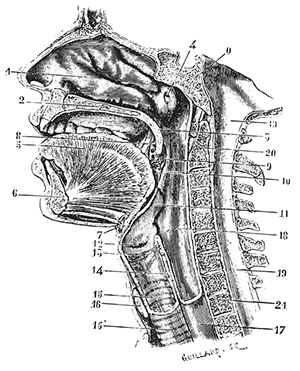
Image Credit: Morphart Creation/SHUTTERSTOCK.com
Explore This Issue
November 2015“It’s potentially good for the patients,” said Richard McHugh, MD, PhD, co-director of the University of Alabama Birmingham Voice and Aerodigestive Center. “The patients might like it better and, potentially, it’s good for us.”
Adam Klein, MD, associate professor at the Emory Voice Center in Atlanta, said physicians could consider performing certain procedures in the endoscopy suite, rather than in the operating room (OR). Doing this frees up OR time, and it’s also an opportunity for physicians to develop new skills, as well as improve patient quality of life. “As you do more awake procedures, you find more applications for it,” Dr. Klein said. The suites generally already have, or can be fairly easily equipped with, what is needed for awake laryngeal procedures, he said, and the rooms are a little larger.
Dr. Klein said his team made the switch at Emory 10 years ago. The endoscopy suites were available to a surprising degree, so the physicians proposed using them for five cases a month. The hospital agreed that this plan would be worth its while. The equipment costs are covered by the hospital, and so is the expense of expired injectables.
Dr. Klein and his colleagues put together a study on the cost and found that it does save money compared with performing the same procedures in the OR. At the same time, due to decreased overhead, the hospital usually nets more. For an injection laryngoplasty, for example, the net gain when performing it in the OR was just $37, but was $315 in the endoscopy suite. “It is less expensive for the system as a whole, and more cost efficient for the hospital,” Dr. Klein said.
Potential Hurdles
Adam Rubin, MD, co-director of Lakeshore Professional Voice Center in Michigan, said that he has incorporated awake laryngeal procedures—while pointing out that he wasn’t necessarily referring to office procedures—into his private practice. Any injections that don’t require an additional scope driver can be done fairly easily, he said, while awake laser procedures and those needing another scope driver are more difficult.
There are some hurdles when it comes to cost, personnel, and critical volume, he said. Just about everything, especially the laser, is expensive, but one cost saving possibility is asking the hospital or the surgical center to buy the laser. That might make sense, because it can be used for general-anesthesia cases and by other specialties, too, he said.
As for personnel, he said the safety net of a hospital or surgical center is reassuring, but many practices are in office buildings, not hospitals. That hurdle can be overcome, he said, by performing procedures in a procedure room or endoscopy suite at the hospital or surgical center, an option that can also be easier and more cost effective.
It’s important to establish a critical volume, in part because some of the procedures can be difficult. “If you’re doing it just sporadically, it can be difficult to develop the skill set and there’s much potential for torture, not just for the patient but for you,” Dr. Rubin said. “It is more difficult if you’re not predominantly doing a laryngology-type practice.”
Seth Dailey, MD, chief of laryngology and voice surgery at the University of Wisconsin School of Medicine and Public Health in Madison, said that it’s not surprising that laryngeal procedures can be challenging, because gagging, laryngeal closure, and cough are measures the body takes to protect itself. “If you try to rush these, it won’t go well,” he said. He added that it’s important that patients’ reactions to a procedure not be so strong that it creates a “memorable event,” a phenomenon involving a spike in circulating catecholamines, which may result in post-traumatic stress disorder. “If you traumatize them, it’s not going to be a good relationship,” he said.
Dr. Dailey added that the reaction can be more favorable with proper positioning: Ask patients to sniff with their chin up and leaning forward, breathing slowly and deeply. One way to get them to relax is to suggest that they “let their muscles go,” rather than to just command them to “relax.” Also, asking them to stare at a fixed point is helpful, as is reducing uncertainty using steps such as introducing them to staff, taking them through the informed consent process, and carefully explaining all the steps.
Other Considerations
Dr. McHugh said that physicians need to be aware of the possibility of complications. Some complications are related to patient tolerance and vagal reactions—including side effects of lidocaine such as secretions, shortness of breath, and dysphagia. There are also anatomic issues, he said. “I’ve run into a few patients where you’re not going to be able to get the larger flexible scope … through their nose,” he said. “Seeing that ahead of time makes a difference, obviously, before you’re struggling inside the patient’s nose.”
There’s also the possibility of an allergy to anesthetics or other medications. An allergy to benzocaine is more likely than one to lidocaine, he noted. Certain complications tend to be procedure-specific. Flexible scope procedures bring a risk of infection and epistaxis. An injection comes with a risk of direct trauma, hematoma, or injection misplacement. Lasers can involve direct trauma or virions carried by the laser plume. “If you perform any procedure a lot,” he said, “you will get a complication.”
Thomas Collins is a freelance medical writer based in Florida.
Take-Home Points
- Consider using the endoscopy suite at your hospital for awake laryngeal procedures.
- Having the hospital buy the laser can help your practice clear a cost hurdle when you are adding awake laryngeal procedures to a private practice.
- Proper positioning and finesse in getting patients to relax are key to smooth procedures.